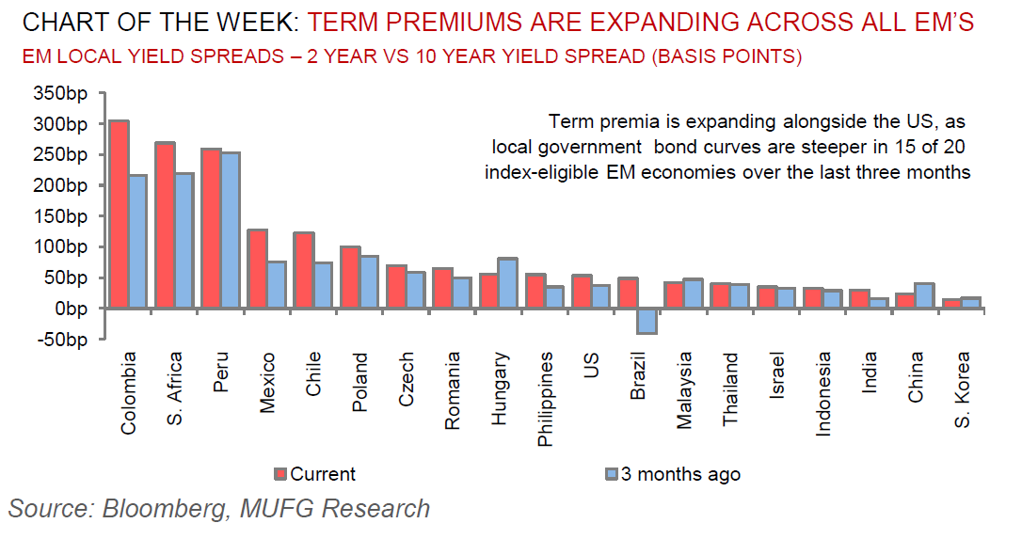Revisiting the reverberations of US tariffs on EM EMEA
EHSAN KHOMAN
Head of Commodities, ESG and
Emerging Markets Research –
EMEA
DIFC Branch – Dubai
T:+971 (4)387 5033
E: ehsan.khoman@ae.mufg.jp
SOOJIN KIM
Research Analyst
DIFC Branch – Dubai
T: +44(4)387 5031
E: soojin.kim@ae.mufg.jp
LEE HARDMAN
Senior Currency Analyst
Global Markets Research
Global Markets Division for EMEA
T: +44(0)20 577 1968
E: lee.hardman@uk.mufg.jp
MUFG Bank, Ltd.
A member of MUFG, a global financial group
Macro focus
Notwithstanding ongoing declarations, hesitations and clarifications surrounding US tariff policy after the initial 2 April “Liberation Day”, our assessment of the implications for the EM EMEA region remains sanguine. At the current juncture, the “direct” exposure of most EM EMEA countries to the announced increases are relatively limited for two reasons. First, even prior to the 90 day reciprocal tariff pause announced on 9 April, the quantum of the tariff increases for most EM EMEA countries was small, since most EM EMEA countries do not have significant trade surpluses with the US. Second, the direct export exposure of EM EMEA economies to US tariffs is relatively limited, as no economy has goods exports to the US that account for more than 3.5% of GDP, and for most the export share is considerably less. Having said that, with a clearer assessment of the global outlook post “Liberation Day”, we revisit our initial assessment on the EM EMEA region and now acknowledge that the “indirect” exposure is likely to be significant for two reasons. First, the tariff increases, especially up to 245% levies on China, are likely to result in manufacturing exports finding their way to non-US markets and competing with goods produced elsewhere, implying lower prices, and potentially also lower activity in those industries that have to compete – especially in the CEE region. Second, there has been a sharp fall in crude oil prices since the 2 April announcement – with the Middle East oil exporters and Russia susceptible.
FX views
The US dollar is now weaker than rate differentials imply, suggesting a discount to reflect policy and structural concerns. With no indication that a new equilibrium for US trade policy has been found, today’s ambiguity has hampered the US dollar’s safe-haven branding. The currency has moved from a position of strength, capitalising on the “US exceptionalism” narrative, to a position of weakness. From an EM FX perspective, the complex has been swung around by the gyrations in US tariff announcements and their impact on risk sentiment. We expect volatility to remain elevated, which warrants a more tactical approach relative to the more trend-like moves in G9 FX. Within that, we noted that most high-beta currencies had underperformed through the first days of April (including the Brazilian Real), but Mexican Peso has outperformed its typical sensitivity to US equities, yields and oil prices.
Week in review
The Central Bank of Egypt (CBE) cut interest rates for the first time in nearly five years, reducing the benchmark deposit and lending rates by 225 bps to 25.0% and 26.0%, respectively, in line with our expectations. The Central Bank of Turkey (CBRT) unexpectedly raised the one-week repo rate by 350bps to 46.00%, against our (and consensus) forecasts to remain on hold. The CBRT also raised the deposit rate by the same margin to 41.00%, but kept the upper end of the corridor wider by raising the lending rate by 30bps to 49.00%. Inflation in Israel fell from 3.4% y/y in February to 3.3% y/y in March, higher than our (and consensus) expectations at 3.2% y/y. Egypt and Qatar said they have agreed to “work towards” a USD7.5bn package on investment package for Egypt – little details offered. Finally, Saudi Arabia inflation accelerated from 2.0% y/y in February to 2.3% y/y in March. The reading was a notch above our 2.2% y/y estimate as we already expected a lift over unfavourable base effects.
Week ahead
It will be a broadly quiet week across EM EMEA. The Central Bank of Russia (CBR) will host a monetary policy meeting on 25 April (MUFG and consensus: on hold at 21.00%), and CPI data for March will be released in South Africa on 23 April (MUFG: -0.1ppts to 3.1% y/y; consensus: -0.200pts to 3.0% y/y).
Forecasts at a glance
The external backdrop for EM has shifted abruptly – the soft-landing pro-risk environment and pricing of non-recessionary Fed cuts has given way to concerns around tariff risks (and likely retaliatory action), higher-for-longer US rates and a strong US dollar. This sets the stage for a challenging EM backdrop in 2025. There are dimensions that could make Trump 2.0 less disruptive. Given the reduced direct trade exposure of the Chinese economy to the US and expectations that there will be a monetary and fiscal response by Chinese policymakers to offset the tariff growth shock, the economic and financial market disruptions will, on aggregate, be less severe than Trump 1.0.
Core indicators
The latest weekly IIF flow data signalled that EM securities witnessed outflows of USD12.9bn in the week ending 18 April, predominantly drive by equities (USD12.6bn) reflecting investor caution on tariff apprehensions.


